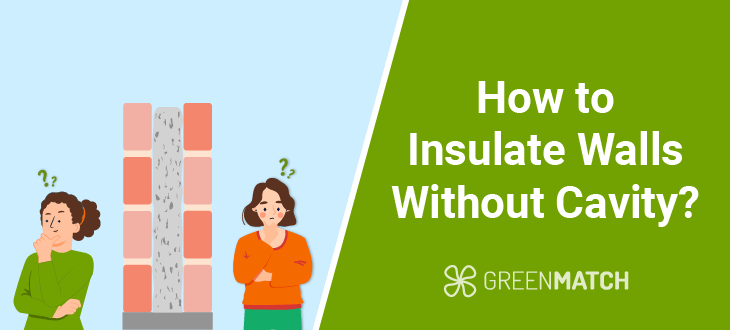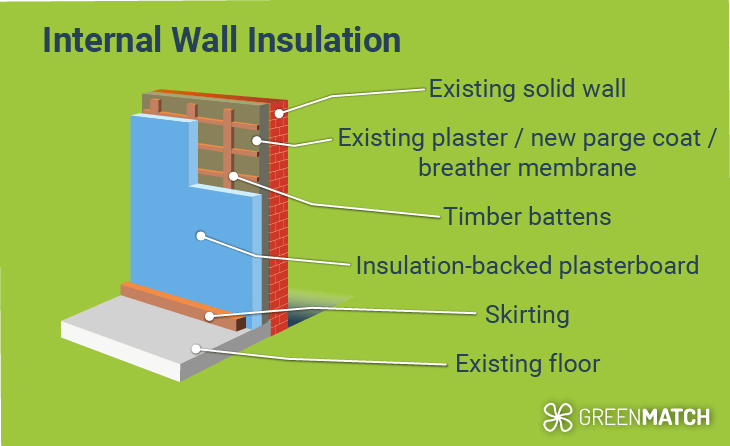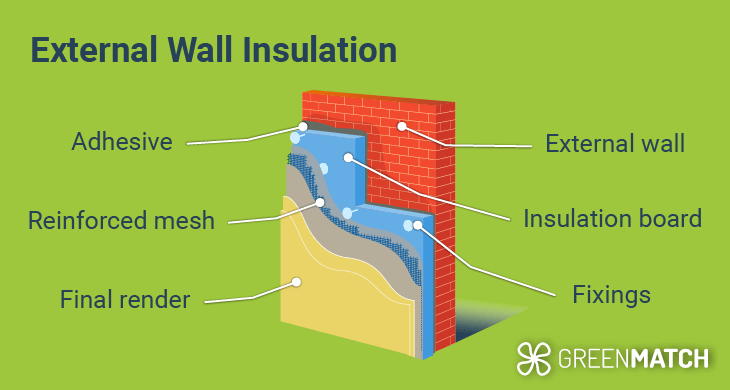Answer these simple questions and we will find you the BEST prices
Which type of solar quotes do you need?
It only takes 30 seconds
100% free with no obligation

Get Free quotes from insulation specialists near you

Save money by comparing quotes and choosing the most competitive offer

The service is 100% free and with no obligation
No Cavity Wall Insulation: Pros, Cons & How Does It Work?


- Both interior and exterior insulation methods are available when considering insulation for a solid wall without a cavity.
- Internal insulation on average, costs around £7,500 and external solid wall insulation approximately £12,000.
- Non-cavity wall insulation can significantly reduce energy bills and heating costs, cut heat loss, improve your home's energy rating, boost property value by 10% or more, and save a semi-detached house up to £290 annually.
As energy prices soar and winter approaches, non-cavity wall insulation for houses, or solid wall insulation, offers a lasting solution for older UK homes built before the 1920s. While costlier than cavity wall insulation, it significantly reduces heat loss, cuts energy bills, and enhances comfort and property value. This option is ideal for homes with solid walls, improving energy ratings where cavity insulation isn't possible.
Has this caught your attention, and are you wondering which is the best way to insulate a house without cavities? Our guide on no-cavity wall insulation in the UK will answer all your questions, covering insulating walls without cavities, their associated costs, and a final review to help you better understand them.
We will not only help you understand the perks of no cavity wall insulation, but we can also help you find reliable installers near you. Instead of spending hours of your time researching professional installers, calling different companies, and comparing their quotes, let us do the hard work for you.
Instead of spending countless hours researching and vetting installers, just spend less than a minute filling out our simple survey and let the bargains come to you. Click on the button below to receive up to 3 non-binding and free quotes from our network of vetted installers!
- Describe your needs
- Get free quotes
- Choose the best offer
It only takes 30 seconds



How to insulate walls without cavity?
There are two ways to insulate homes without cavity walls: internal or external insulation. But which is the best way to insulate a house with non-cavity walls?
- Regarding home insulation, a “cavity wall” refers to a double-layered wall with a gap or cavity space in between. The outer layer is usually brick, while the inner layer can be brick or concrete. These walls can absorb rainwater and allow heat to escape from your home.
- In contrast, solid or non-cavity walls have no gap. You can often identify solid walls by looking at the brickwork pattern from the outside. If you see some bricks positioned with their shorter ends visible (creating an alternating pattern), it’s likely a solid wall. This pattern is called “header bonding” and is characteristic of older, non-cavity wall construction that normally pre-date the 1920s.
Internal insulation is when insulation material, such as rigid sheet insulation, is directly fixed onto the interior walls of your home and covered in plasterboard. Alternatively, stud walls can be built within your home, filled with insulation such as mineral wool, and then covered with plasterboard. While it's an effective method, it can reduce room size by about 100mm, potentially disrupting daily life during installation.

External insulation involves fixing insulation material to the outer walls of your home and then covering it with plaster and cladding insulation. This method enhances weatherproofing and sound isolation without interior disruption but is more expensive and may require planning permission due to changes in the home's appearance.

Choosing the best method depends on your home's needs, potential disruption, and budget.
How much does non-cavity wall insulation cost?
The cost of insulation ranges from £7,500 to £12,000, depending on the type of insulation you choose. External insulation, for instance, tends to be more expensive than internal insulation; however, it enhances a home's thermal efficiency without reducing interior space while also improving weatherproofing and sound isolation.
Moreover, external insulation causes minimal disruption to daily life since the work is done outside, though it is generally more expensive and may require planning permission. Internal insulation, while typically cheaper, reduces room size and can significantly disrupt daily activities during installation. External insulation also offers the benefit of refreshing the home’s exterior appearance.
While these costs may seem steep, there are different insulation grants in the UK to support homeowners in their decisions. The UK government launched the Great British Insulation Scheme (GBIS) to help qualifying homes with wall insulation completely free of charge.
The Energy Company Obligation (ECO4) scheme is also available. It offers insulation grants to reduce carbon emissions, energy use, and fuel poverty in the UK. It targets fuel-poor households by placing a Home Heating Cost Reduction Obligation (HHCRO) on medium to large energy suppliers, requiring them to provide efficient heating and insulation measures to low-income households.
| Insulation type | Cost range | Grants available |
|---|---|---|
| Internal insulation | £7,500 | Great British Insulation Scheme (for eligible households), Energy Company Obligation (ECO4) - HHCRO (for low-income and fuel-poor households) |
| External insulation | £12,000 | Great British Insulation Scheme (for eligible households), Energy Company Obligation (ECO4) - HHCRO (for low-income and fuel-poor households) |
These costs are estimates, and available insulation grants may change with new government policies. Therefore, we strongly recommend consulting with a specialist. This will help you stay informed about the latest trends and costs, compare quotes, and save time and money by connecting directly with professionals.
Click the button below to get started; it takes less than a minute!
- Describe your needs
- Get free quotes
- Choose the best offer
It only takes 30 seconds



Is non-cavity wall insulation the right option for your UK home?
Solid wall insulation is ideal for older UK homes built before the 1920s. You have two main options: external insulation, which costs around £12,000, or internal insulation, which costs about £7,500. While it's a significant investment, government schemes like the GBIS and ECO4 offer grants to help make homes more energy-efficient, especially for low-income households.
External insulation keeps your living space intact and improves weatherproofing, while internal insulation is cheaper but slightly shrinks rooms. Both need expert installation and careful moisture management. Don't forget to consider planning permissions, potential disruption, and warranties. You can save money by combining wall insulation work with other home improvements.
Overall, solid wall insulation can greatly benefit older UK homes, but it requires thoughtful planning. It's best to chat with a professional to determine the right approach for your specific home.
Fortunately, with our service, finding a reliable professional and comparing quotes couldn’t be easier. Just fill in our short form, and we’ll connect you with up to 3 free home-tailored quotes. Spare yourself the hassle of endless googling, and click below to get started—it’s quick, simple, and completely free!
- Describe your needs
- Get free quotes
- Choose the best offer
It only takes 30 seconds



FAQ
Yes, you can insulate solid or non-cavity walls either externally or internally, both having their pros and cons. For the best results, we strongly recommend consulting an insulation expert who can assess your specific situation and provide tailored advice.
Yes, non-cavity wall insulation, also known as solid wall insulation, is a great alternative to houses with non-cavity walls. The two forms of solid wall insulation are internal and external. Both have their own price ranges and pros and cons to consider.
Two options are available for non-cavity walls: external insulation (around £12,000) and internal insulation (about £7,500). While expensive, government schemes like the Great British Insulation and ECO4 offer grants to help low-income households improve their homes’ energy efficiency.

Alejandro is a copywriter at GreenMatch and is passionate about European environmental policy and renewable energy. He has conducted research on the European Green Deal’s impact on EU energy policy and climate adaptation, and he is committed to using his writing skills to promote sustainable policies.
We strive to connect our customers with the right product and supplier. Would you like to be part of GreenMatch?

